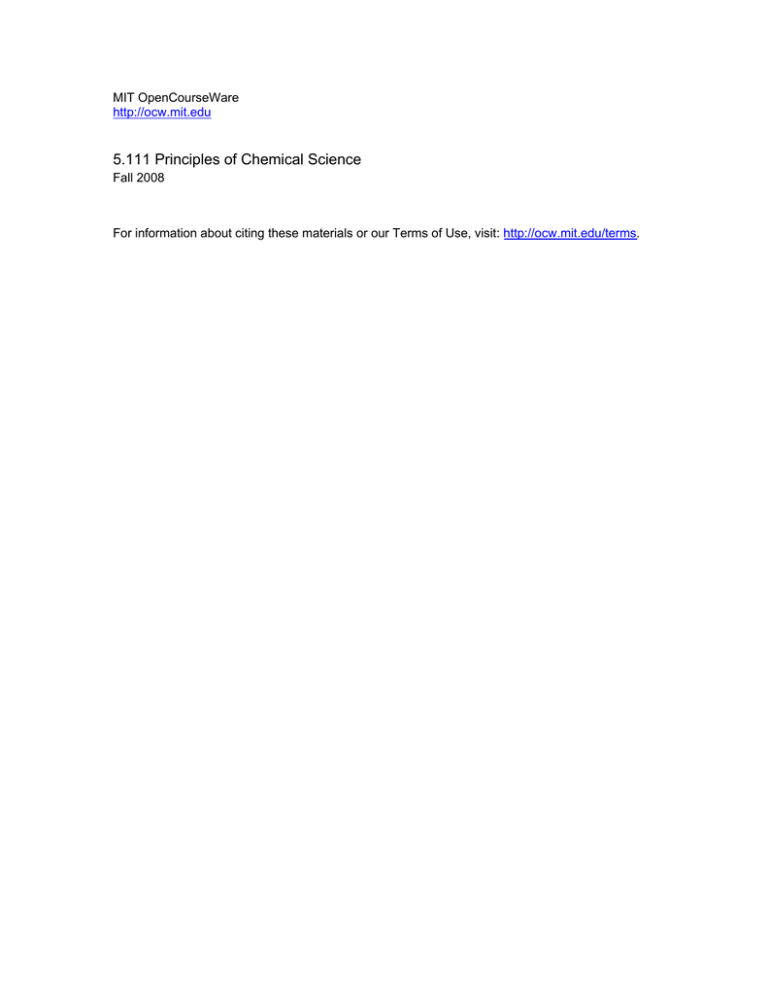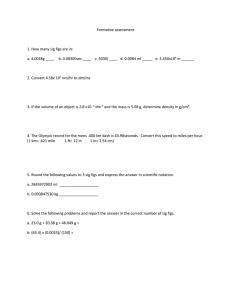5.111 Principles of Chemical Science MIT OpenCourseWare Fall 2008 rms of Use, visit:
advertisement

MIT OpenCourseWare http://ocw.mit.edu 5.111 Principles of Chemical Science Fall 2008 For information about citing these materials or our Terms of Use, visit: http://ocw.mit.edu/terms. 5.111 Lecture Summary #20 20.1 CHEMICAL EQUILIBRIUM Topics: External effects on K and sig figs for logs. Chapter 9 sections 9.10-9.13 Recall Principle of Le Châtelier: A system in equilibrium that is subjected to stress will react in a way that tends to minimize the effect of the stress. CHANGING THE VOLUME A decrease in the volume of a gaseous system causes an increase in the total pressure. Le Châtelier's principle predicts that the system would respond, if possible, in such a way as to reduce the total pressure. Example 2P2 (g) P4 (g) A decrease in volume shifts the reaction to the right (toward product). This occurs because for every 2 molecules of P2 consumed only 1 molecule of P4 is formed. A shift to the right reduces the total pressure, partially compensating for the external stress of the volume change. compress expand Now Consider in terms of Q and K. Suppose the volume is decreased by a factor of 2 at constant temperature. This will increase the partial pressure of P2 by 2 and of P4 by 2, initially. PP Q = 4 (PP ) 2 2 = 2 22 = 1 2 Q decreases by a factor of 2, and Q < K. ∆G is negative. Reaction proceeds in forward direction (toward products) until Q=K again. In contrast, increasing the volume shifts the reaction to the left (toward reactants). 5.111 Lecture Summary #20 20.2 ADDING INERT GAS 1) For 2P2 (g) P4, what happens if an inert gas is added to the container increasing the total pressure at constant temperature? Answer: _____________ Why? Q depends on the partial pressure of P2 and P4 gases and the partial pressures do not change here. Review Partial Pressure: The partial pressure is the pressure that each gas would exert if it alone were present in the container. 1 atm O2 1 atm 2 atm N2 mixture of O2 and N2 PA = nA RT V Ptot = P A + PB + P C + etc = (nA + nB + nC + etc) RT = V ntot RT V 2) What happens if an inert gas is added to the container but the total pressure and temperature are kept constant? For the pressure to be kept constant, the volume of the container must have been increased. 5.111 Lecture Summary #20 20.3 CHANGING THE TEMPERATURE Raising the temperature of an equilibrium mixture by adding heat causes the reaction to shift such that some of the heat is absorbed. Le Châtelier's principle is consistent with this observation. Raising the temperature of an exothermic reaction favors the formation of reactants. Raising the temperature of an endothermic reaction favors the formation of products. Here ∆H is the predictive tool Example 2SO2 (g) + O2 2SO3 (g) ∆H° = -197.78 kJ/mol If heat is added, which direction will the reaction go? TEMPERATURE DEPENDENCE OF K K can change with temperature and reaction rates can change with temperature. ∆G° = -RT ln K = ∆H° - T ∆S° or ln K = -∆H°/RT + ∆S°/R Since it is reasonable to assume that ∆H° and ∆S° are approximately independent of temperature over the range of temperatures of interest, K changes with a change in T. Consider a reaction carried out at Temperatures T1 and T2: ln K2 = -∆H°/RT2 + ∆S°/R and ln K1 = -∆H°/RT1 + ∆S°/R Subtracting the second equation from the first gives: ln K2 K1 = - ! H° 1 1 - R T1 T2 If ∆H° < 0 T2 > T1 then (-)(-)(-) = (-) K1 > K2 T2 < T1 then (-)(-)(+) = (+) K1 < K2 If ∆H° > 0 T2 >T1 then (-)(+)(-) = T2 < T1 then (-)(+)(+) = K1 K2 K1 K2 Van't Hoff Equation 5.111 Lecture Summary #20 20.4 MAXIMIZING THE YIELD OF A REACTION N2(g) + 3H2(g) 2NH3(g) exothermic reaction low temperature favors products, good but low temperature slows rate, bad Compromise temperature used is 500°C. What are other ways to drive the reaction toward products? Bacteria can catalyze the same reaction using an enzyme called nitrogenase. LE CHÂTELIER AND HEMOGLOBIN The combination of oxygen with hemoglobin (Hb), which carries oxygen through the blood, can be represented by Hb (aq) + O2 (aq) HbO2 (aq) where HbO2 is oxyhemoglobin (oxygen bound to hemoglobin) At an altitude of 3 km the partial pressure of oxygen is only about 0.14 atm, compared to 0.2 atm at sea level. According to Le Châtelier's principle, the equilibrium would be shifted to the left. This change causes hypoxia. How can the body compensate? SIG FIG RULES FOR LOGS AND EXPONENTIALS (APPENDIX 1C, D (PAGE A5-A7) log (7.310 x 103) = 3.8639 (4 sig figs in mantissa) log (7.310 x 1023) = 23.8639 (4 sig figs in mantissa) The characteristic (left of decimal point) is determined solely by the location of the decimal point in the number and not by the number's precision, it is not included when counting sig figs. The mantissa (right of decimal point) should be written with as many sig figs as the original number. 100.389 =2.45 (3 sig figs in answer) 1012.389=2.45 x 1012(3 sig figs in answer)



